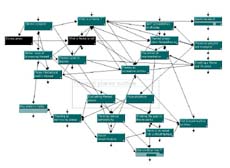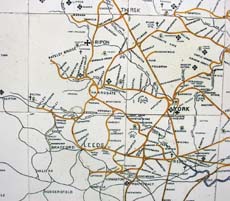index
Places and hypertexts
click on images for full-size:



Map of one region of this current text

Map of rail connections in northern England
One trope in this study is the comparison of contemporary places to hypertexts. Nodes in a hypertext -- especially in those more literary than this one -- really do find their identity in their links rather than in being independent chunks of information or description. Nodes may also be intimately related yet quite separated in the text or in the process of reading. The idea of this comparison first occured to me when writing a talk, "The Age of the List," for a conference on preservation held in Rome some years back (Kolb 2000c). Material from that talk appears as part of the description of suburban strips, but the talk went further in discussing the penetration of older centers by new forces and links. Those ideas now appear scattered throughout this study.There are, however, some serious qualifications to be made about my parallel between contemporary places and hypertexts. While connections in a hypertext are intentional, physical space provides a set of contingent and non-intentional connections as well as the intentional architectural or place norm connections. Still, it is no accident that my study of contemporary places came after I wrote both a book on postmodernism in architecture and philosophy, and a hypertext on non-linearity in philosophy. The narratives included in this study show other ways in which my experiences have inspired these reflections.